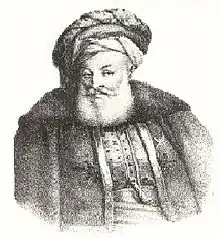Ahmed Bey ben Mohamed Chérif
Ahmed Bey ben Mohamed Sherif, also known as Ahmed Bey or Hadj Ahmed Bey (Arabic: الحاج أحمد باي) (c. 1784 - c. 1850) was the last Ottoman Bey of Constantine, in the Regency of Algiers, ruling from 1826 to 1848.[1] He was the successor of Mohamed Menamenni Bey ben Khan. As head of state, he led the local population in a fierce resistance to the French occupation forces.[2] In 1837 the territory was conquered by the French, who reinstated the Bey as ruler of the region. He remained in this position until 1848, when the region became a part of the colony of Algiers and the Bey was deposed.
Hajj Ahmed Bey Ben Mohammed Sherif الحاج أحمد باي بن محمد شريف | |
|---|---|
 Portrait of Ahmed Bey | |
| Born | around 1784 |
| Died | August 30, 1851 (aged 65) |
| Nationality | Ottoman Algerian |
| Citizenship | Ottoman |
| Known for | Last bey of Constantine French conquest of Algeria Battle of Constantine Siege of Constantine |
Early life and career
Ahmed Bey was born a "kouloughli" meaning he was born to a Turkish father and an Arab mother.[3] Barely eighteen years old, the bey Abd Allah gave him the title of Caïd of the El Aouassi (Chief of Harakta tribes). Following the earthquake in the Blida region the dey controlled, he appointed him to Hunah el Kadous, around Algiers, and gives him the enjoyment of haouch Ouled Baba. Ahmed Bey engaged in many pastimes, such as hunting and horse riding. From time to time he took part in expeditions to protect Ottoman troops, who were engaged against hostile Kabyle tribes such as the Beni Menad and the Beni Djenad. During his pilgrimage to Mecca, which lasted fifteen months, in Egypt he met several famous people, including Muhammad Ali Pasha, his son Ibrahim Pasha and Tusun Pasha.
Bey of Constantine and French invasion
Appointed Bey of Constantine in 1826, he modernized the country focusing on the army. He led the Algerian resistance against the French occupation forces in the eastern Algeria with the aid of Hussein Pasha and, after the capture of Algiers, he retired in his province to Constantine. In 1832 he entrusted his lieutenant Ben Aïssa the care for the population of Bône. He continued to organize the defence of Constantine, Algeria, and lead several battles against the French army.
In January 1834, the Bey of Constantine Hadj Ahmed Bey and the chiefs of many tribes around Constantine sent a petition to the British Parliament to seek the help of Britain against French forces.
He won his first success in 1836 against maréchal Clauzel. When Constantine was besieged by the French in 1837, Ahmed Bey managed to escape and to organize resistance in the Aurès Mountains. In 1842, he rallies the tribe of Ouled Nasser, hoping to provide support with the Kabyles, and approached the camp of Ain Roumel. On 25 August 1842, French General Jean-René Sillègue enters the land of the Amouchas, namely a village north of Sétif, and met a gathering of two to three thousand Kabyles who failed to stop him. On September 10, the General defeated the Cavalry of Hadj Ahmed Bey at the foot of Djbel Bou Taleb, and manages to destroy his influence on the tribes of the Tell.
Death
Ahmed died on August 30, 1850, 65 years old. According to his wishes, he is buried in Algiers in the Thaalibia Cemetery near the mosque of Sidi Abder Rahman of Algiers in the Casbah of Algiers. His marble mausoleum is surmounted by a turban.
References
- A History of the Maghrib in the Islamic Period Jamil M. Abun-Nasr
- Henache, Delila. "Algerian director Ali Aissaoui awarded 'Golden screen 2008' for 'Hello Constantine'" Archived 2011-07-24 at the Wayback Machine Echorouk Online. November 18, 2008. Accessed December 22, 2008
- Alexis Tocqueville, Second Letter on Algeria (August 22, 1837), Bronner, Stephen Eric; Thompson, Michael (eds.), The Logos Reader: Rational Radicalism and the Future of Politics, (University of Kentucky Press, 2006), 205;"This bey, contrary to all custom, was coulougli, meaning the son of a Turkish father and an Arab mother."
Bibliography
- Tocqueville, Alexis de (2006), "Second Letter on Algeria (August 22, 1837)", in Bronner, Stephen Eric; Thompson, Michael (eds.), The Logos Reader: Rational Radicalism and the Future of Politics, University Press of Kentucky, ISBN 0813191483.